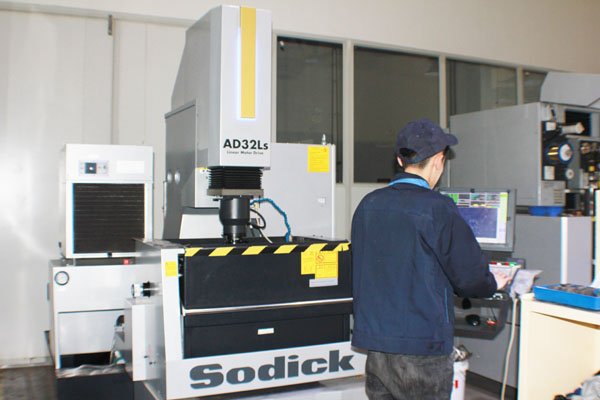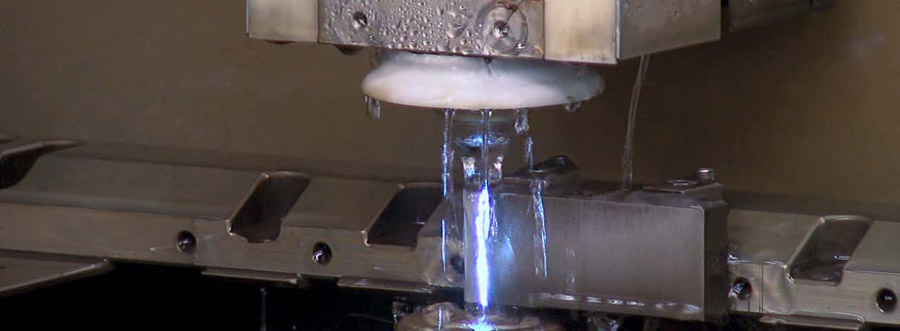EDM is popular for obtaining extremely complex shapes that are difficult to machine with milling. It also excels in different applications of hard materials like titanium. EDM is a subtractive manufacturing technique that uses electrical discharge for machining. There are two types of EDM, sinker EDM and wire EDM. This article looks at the differences between the two machining processes and points out the applications, features, and advantages of each.
What is Sinker EDM?
Sinker electrical discharge machining, sometimes known as ram EDM, volume EDM, or cavity EDM.
Sinker EDM requires electrodes, insulating fluid and a power source. The power supply connects the electrode and the workpiece. The spark from the connection creates a channel. Unlike wire EDM, sinker EDM services do not completely cut the material. This enables our operators to produce complex shapes. At the same time, it does not create stress in the material. This makes it an excellent means of producing injection molds and stamping dies.
Sinker EDM machines use electrodes and workpieces immersed in liquids such as oil or dielectric water. A power source is connected to the electrodes and creates an electrical potential between the two parts, creating a breakdown to create the plasma channel and spark jumps. The sparks from the power supply tend to come one after the other.
As the sparks continued to form, the base metal began to corrode and the electrodes were lowered, causing the “bump” or “sink” effect of this EDM machine. When the process is complete and each part is removed, the base metal has been eroded into a very specific shape or design – similar to engraving. EDM machines process hard metals faster, providing companies with the best efficiencies in industrial production today.

What is Wire EDM?
Wire Electric Discharge Machining (EDM) Wire EDM uses a single thin wire to cut thick metal to achieve precise cuts and divisions that are not possible with standard CNC machines. Similar to Ram EDM, Wire EDM uses electrodes and sparks to cut metal. Using spark erosion technology, Wire EDM machining immerses the part being cut in deionized water, and the wire acts as an electrode, creating a spark to rough or scrape the part into the desired shape without the wire coming into contact with the part. Automatic wire feed ensures that the wire never wears out and the cut is consistent for repeatable accuracy.
During in-line EDM machining, a thin metal wire is sandwiched between two diamond guides, one above and one below the workpiece, and moved along the X and Y axes according to CNC commands. (The upper rail may also move along other axes for more complex cuts.) As with other EDM processes, electrical discharge can cause sparks between the wire and the workpiece, which can lead to corrosion of the workpiece.
In the wire EDM process, very fine gauge wire (down to 20 microns in diameter) can be used, which enables very fine cuts on the workpiece. However, as with sinker EDM, it is common practice to start with roughing and then finish.
What is the difference between Sinker EDM and Wire EDM?
Electric current is used to cut or burn away the conductive material in Wire EDM and Sinker EDM. In both processes, the electrode does not come into contact with the material being processed. Unlike Wire EDM, Sinker EDM services do not fully cut the material (unless required), resulting in a wider range of applications such as blind cavities/keyways, thin walls or cross sections. This versatility makes subsidence EDM an effective technology for stamping and injection mold assemblies.

Applications Of Sinker EDM and Wire EDM
Sinker EDM is used to make complex cavities and is therefore particularly suitable for making dies, dies and other forms of tooling – especially hard materials such as tool steel. It also produces sharp interior corners and deep ribs better than other machining processes.
Common sinker EDM applications include:
- Quick Die
- mold making
- Injection mold
- mold
- fine details
- sharp interior corners
- deep and thin ribs
- blind cavity
- blind keyway
- Internal spline
Wire EDM is often used to cut very thick hard metal sheets rather than traditional machining processes. It is a popular process for producing punches, tools and dies. Wire EDM does not cause part distortion and produces a good surface finish.
Common WEDM applications include:
- thick plate
- Extrusion Die
- Blanking punch
- Automotive and Aerospace Parts
- Tight tolerance parts
- Medical and Dental Equipment
- Where burrs are unacceptable
- Thin parts that can break during conventional machining
SANS Machining is a prototyping and low-volume manufacturing specialist with expertise in all forms of machining. You can always contact our engineers for technical support to get a clear understanding of each step and function.


